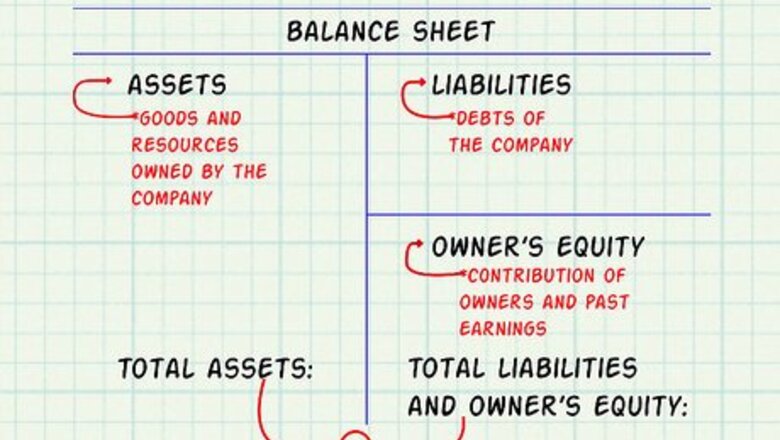
views
X
Research source
It shows a company's assets, liabilities, and equity accounts.[2]
X
Expert Source
John Gillingham, CPA, MACertified Public Accountant
Expert Interview. 3 March 2020.
Financial professionals will use the balance sheet to evaluate the financial health of the company.
Setting Up Your Balance Sheet
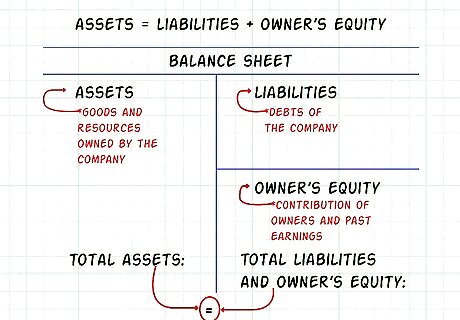
Use the basic accounting equation to make a balance sheets. This is Assets = Liabilities + Owner's Equity. Thus, a balance sheet has three sections: Assets, which are the resources owned; Liabilities, which are the company's debts; and Owner's Equity, which is contributions by shareholders and the company's earnings. The information needed to complete a balance sheet can be found on the company's general ledger where all financial transactions for a particular period will have been recorded. In a balance sheet, the total sum of assets must equal the sum of liabilities and owner's equity. The asset accounts represent all the goods and resources that a company owns. The liability portion represents all of its debts. The equity portion represents contributions by owners (shareholders) and past earnings. Theoretically, all the assets of the company are either financed by borrowing, which is associated with the liability accounts, or are financed by past earnings and contributions from owners, which are associated with equity.
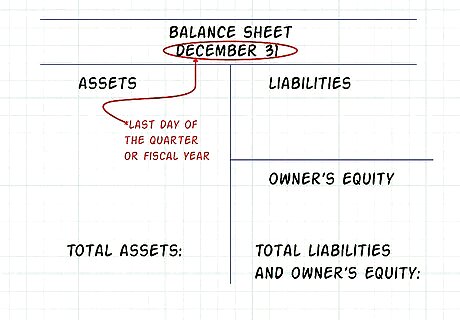
Choose the date for the balance sheet. The balance sheet is created to show the assets, liabilities, and equity of a company on a specific day of the year. Usually companies prepare an official balance sheet quarterly ( the last day of March, June, September and December, for example) and at the end of their fiscal year (such as December 31) but it can be done at any time. You might not finish putting together the balance sheet until several weeks after the end of the fiscal year (Dec. 31 for example), but your data collection end date and balance sheet date would still be December 31.
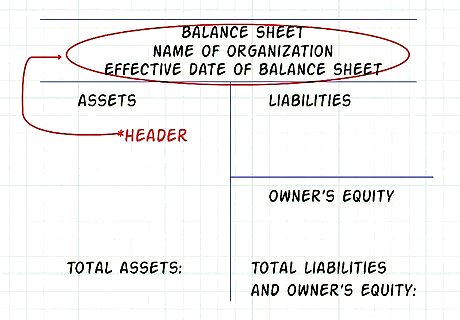
Prepare the header of the balance sheet. Use the title “Balance Sheet,” at the top of the page. Beneath it, list the name of the organization, and the effective date of the balance sheet (the last day of the quarter or fiscal year).
Preparing the Assets Section

List all current assets. Current assets are assets that can turn into cash within one year of the balance sheet date. They are listed in order of relative liquidity, in other words how easily they could be converted into cash. Common current asset accounts include cash, marketable securities (such as stocks, bonds, etc.), accounts receivable, supplies, inventory, and prepaid expenses (such as prepaid insurance, prepaid rent, etc.). Include a subtotal of the current assets accounts and call it “Total Current Assets.”
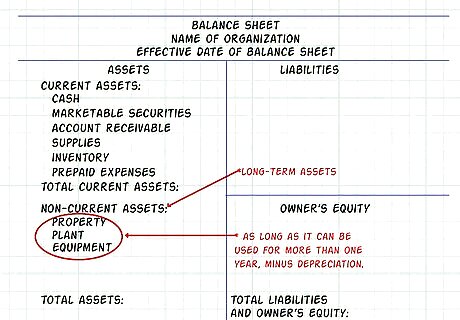
List all non-current assets, also known as long-term assets. Non-current assets are defined as a company's value of property, plant, and equipment that can be used for more than 1 year, minus depreciation. The general ledge will indicate the current value of long-term assets.

Include any intangible assets. These are also considered non-current. Intangible assets refer to non-monetary assets that have no physical substance and will last more than 1 year. These include patents, copyrights, trademarks, and other rights. Non-tangible assets will have a value in the general ledger to establish cost. For example, if legal and filing fees for patents totaled $50,000, that is the cost that will appear on the company ledger and on the balance sheet. Include a subtotal of the non-current assets and call it “Total Non-Current Assets.”
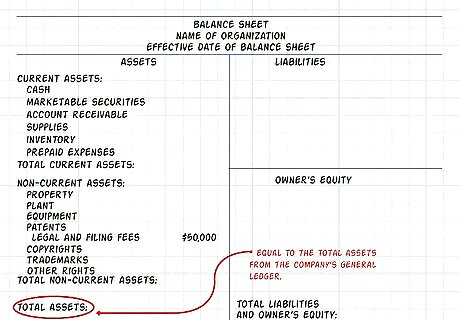
Add up the current and non-current assets totals and label this amount “Total Assets.” Here, check that the total assets per your balance sheet are equal to the total assets from the company's general ledger. Investigate and resolve any differences you find.
Preparing the Liabilities Section
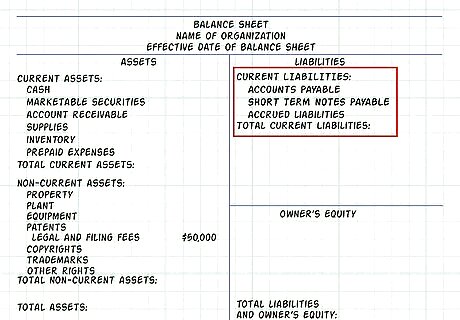
Determine current liabilities. Current liabilities are liabilities that are due within one year of the balance sheet date. Common current liabilities accounts include: accounts payable, short-term notes payable, and accrued liabilities. Include a subtotal of the current liabilities and title it “Total Current Liabilities.”
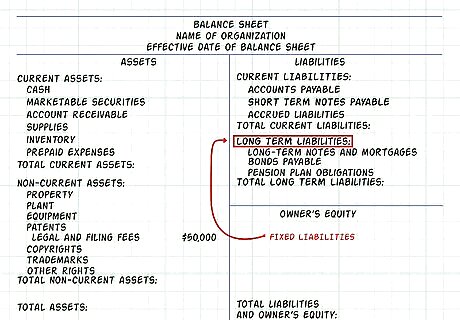
Calculate all long-term liabilities, also known as fixed liabilities. These are any liabilities that will not be settled within one year. Long-term liabilities include: long-term notes and mortgages, bonds payable, and pension plan obligations. Include a subtotal of long-term liabilities and label this line “Total Long-term Liabilities.”
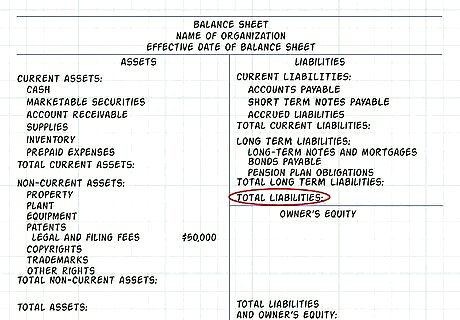
Add the current liabilities subtotal to the long-term liabilities subtotal. Label this line “Total Liabilities.” The balance for total liabilities will be shown on the second part of your balance sheet and will be added to the owner's equity.
Calculating Owner's Equity and Totals
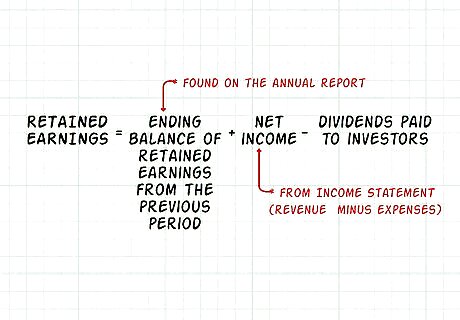
Calculate Retained Earnings. Retained earnings are the amount of profit a company has earned for a particular time period. First find the ending balance of retained earnings from the previous period (found on the annual report), add the net income (revenue minus expenses) from your Income Statement, deduct dividends paid to investors, and get the final total for current retained earnings. The Statement of Retained Earnings will not be listed on your balance sheet but will help you calculate owner's equity.
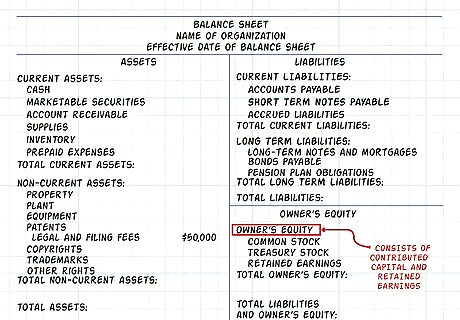
Calculate the owner's equity. Equity consists of contributed capital (money invested) and retained earnings (historical sum of profits and losses). Here, make a list of all the equity accounts like common stock, treasury stock, and the retained earnings number from Step 1. Once all the equity accounts are listed, sum them and add the caption “Total Owner's Equity.”

Add the “Total Liabilities” and “Total Owner's Equity” figures. Title the sum “Total Liabilities and Owner's Equity." The balance sheet has been correctly prepared if “Total Assets” and “Total Liabilities and Owner's Equity” are equal. If this is the case, then your balance sheet is now complete. If balance sheet does not balance, double check your work. You may have omitted, duplicated, or miscategorized one of your accounts. Also double check your retained earnings balance, as this is a common problem area.



















Comments
0 comment